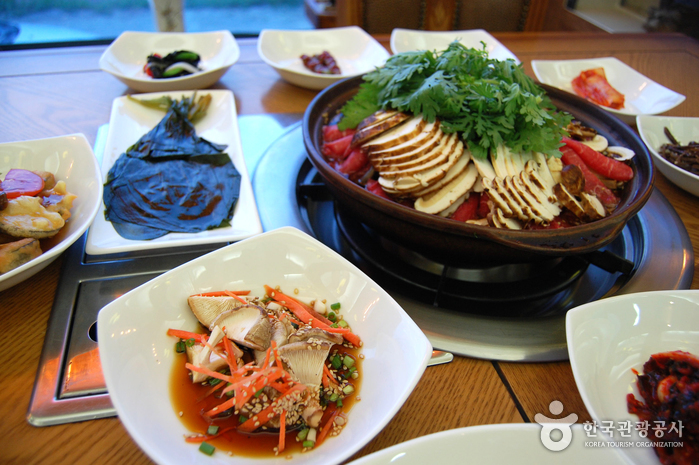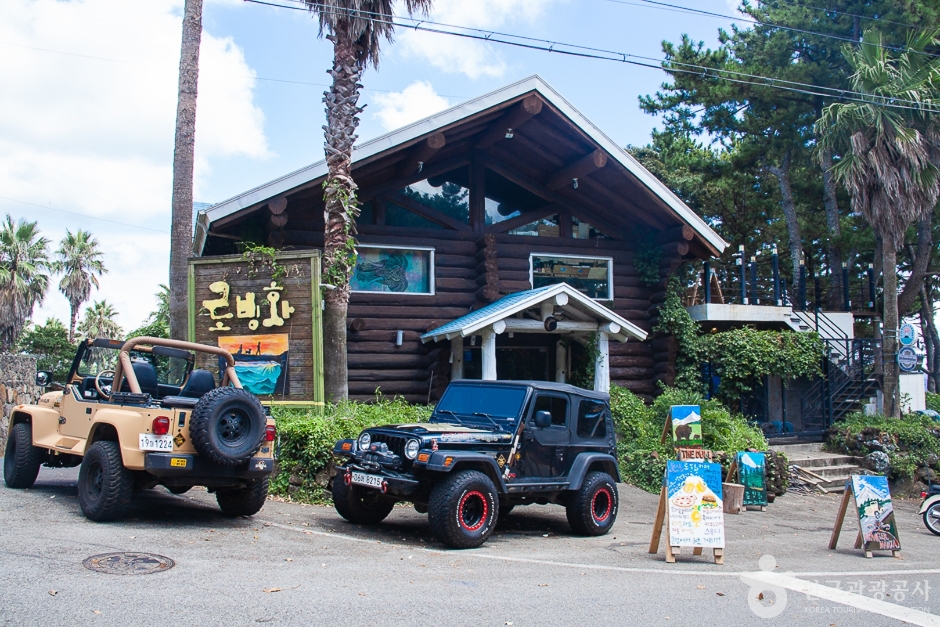Yeonsan Halmeoni Sundae (원조연산할머니순대)
2024-02-28
1525 Hwangsanbeol-ro, Yeonsan-myeon, Nonsan-si, Chungcheongnam-do
Yeonsan Halmeoni Sundae is a sundae specialty restaurant located near Yeonsan Market. It has been passed down for four generations, insisting on the traditional taste. The representative menu is sundae gukbap (sundae and rice soup), which puts sundae and various internal organs in a milky broth. The broth is made by boiling pork bones, and the sundae is handmade using only pure pork blood and green onions. They also offer a sundae jeopsi (assorted sundae) and ttaro gukbap (rice and soup).
Songibeoseot Maeul (송이버섯마을)
2024-12-27
55-20 Namdaecheon-ro, Yangyang-eup, Yangyang-gun, Gangwon-do
033-672-3145
This restaurant serves a variety of dishes made with pine mushrooms. You can, for instance, enjoy songibeoseot jeongol (pine mushroom hot pot) with Korean beef in a shabu-shabu style. After eating the mushrooms and the beef, you can add noodles to the soup, which goes quite well with the broth, now richly infused with the flavors of pine mushrooms and Korean beef.
The Dull Ice Flower (로빙화)
2024-02-28
13 Namtaehaean-ro, Namwon-eup, Seogwipo-si, Jeju-do
The Dull Ice Flower is a pub and café known for its captivating exotic interior. The signature menu item is a flavorful handmade burger made with high-quality beef and black pork from Jeju. The thin-crust pizza and french fries are also popular. The interior resembles a mountain hut with an atelier, offering visitors sea views.
Dongbangmyeongju Chungmuro Main Store (동방명주 충무로점)
2024-02-28
186 Toegye-ro, Jung-gu, Seoul
Dongbangmyeongju is a Chinese cuisine restaurant located near Namsangol Hanok Village. The flagship dish is jjajangmyeon (black bean sauce noodles), and they offer a variety of other menu items such as tangsuyuk (deep-fried pork with sweet and sour sauce) and sacheontangmyeon (Chinese Sichuan noodle soup). The surrounding area boasts various attractions and culinary delights, including Myeongdong and Namsan Tower, providing a panoramic view of Seoul.
Sanchae Restaurant (산채식당)
2024-02-28
72, Palgongsan-ro 185-gil, Dong-gu, Daegu
053-985-4082
Sanchae Restaurant is a wild vegetable Korean restaurant situated at the entrance of Palgongsan Cable Car. Since its opening in 1995, the restaurant has passed onto its second generation, maintaining the authentic flavors that have defined its success. With a commitment to recreating traditional homemade meals, Sanchae Restaurant uses self-cultivated vegetables, perilla seeds, garlic, chili pepper powder, and homemade fermented condiments. Among its signature dishes, the sannamul bibimbap (wild vegetable bibimbap) stands out, showcasing a delightful blend of seven namuls (salad) seasoned with a savory soy sauce.
Café Calming
2024-02-28
311 Soraji-ro, Paju-si, Gyeonggi-do
Café Calming is a serene dessert café celebrated for its stunning view of the Hangang River, offering a tranquil escape. The café's signature dish is the saengmango bingsu (shaved ice with fresh mango), which is garnished an entire sliced mango on top. Its spacious interior and outdoor terrace provide plenty of seating, with the terrace exuding the feel of a Southeast Asian resort. Alongside this, the café serves homemade scones that complement their slightly sour espresso perfectly. A notable highlight of the Café Calming is its stunning views of the Hangang River at sunset.
Baeteojineun Jip (배터지는집)
2024-02-28
6 Gubong-gil, Danwon-gu, Ansan-si, Gyeonggi-do
Baeteojineun Jip, nestled in Daebudo Island, is a renowned specialty restaurant celebrated for its flavorful bajirak kalguksu (noodle soup with clams). The menu highlights signature dishes such as the seafood broth-based bajirak kalguksu and the yangpun boribap (steamed barley rice in large brass bowl). Notably, their yeongyang gulbap (nutritious oyster rice), a hot stone pot brimming with plump oysters, stands as a popular choice among diners. The restaurant's offering of unlimited servings of sweet and robust dongdongju (rice wine) has made it a sought-after destination for patrons seeking to pair dongdongju with haemul pajeon (seafood and green onion pancake).
Dongbaekgung Dongbaek Branch (동백궁 동백점)
2024-02-28
489 Dongbaekjukjeon-daero, Giheung-gu, Yongin-si, Gyeonggi-do
Dongbaekgung, featuring a traditional hanok interior, specializes in dwaeji galbi gui (grilled pork galbi) and sogalbi gui (grilled galbi). Their standout dishes are yangnyeom galbi gui (grilled marinated galbi) and saenggalbi gui (grilled galbi). The menu also includes a la carte items such as galbitang (galbi soup), yukhoe bibimbap (beef tartare bibimbap), and Hamheung naengmyeon (Hamheung cold buckwheat noodles). A popular lunch choice is the sutbul hanjeongsik (Korean table d'hote with charcoal-grilled dish), which includes hot pot rice and a selection of grilled dishes like jumulleok (spicy stir-fried pork), yangnyeom galbi (grilled marinated galbi), and saenggalbi (galbi).
Bangpo Susan (방포수산)
2024-02-28
64, Bangpohang-gil, Anmyeon-eup, Taean-gun, Chungcheongnam-do
Bangpo Susan serves hoe (sliced raw fish) made with fresh seafood chosen from the massive fish tanks in the shop. One can enjoy a robust meal with a small table charge, particularly the chewy texture of fresh hoe (sliced raw fish) and spicy maeuntang (spicy fish stew). Bangpo Susan is located between Kkotji Beach and Bangpo Port, where one can enjoy fresh hoe (sliced raw fish) with a view of the sea.
Baek Ni Hyang (백리향)
2024-02-28
57F, 50 63-ro, Yeongdeungpo-gu, Seoul
Baek Ni Hyang is a Chinese restaurant located in Yeouido 63 Square. Combining traditional cooking methods from the Guangdong and Sichuan regions of China with influences from Beijing and Sichuan styles, the restaurant offers Chinese cuisine using seasonal ingredients. The signature dishes include buldojang (Buddha's temptation soup) and dongpayuk (red braised pork belly). The proximity to the Hangang Park and Yeouido Park makes it a great place for a leisurely stroll.



 English
English
 한국어
한국어 日本語
日本語 中文(简体)
中文(简体) Deutsch
Deutsch Français
Français Español
Español Русский
Русский